ADA (Americans with Disability Act)
- The full act at Title III Places of Public Accommodation (nicely formatted) -and/or-
- online documentation for section 36.302 (text that can be copied) that also has a fair bit of information regarding commentary on the act and the lawmakers subsequent interpretations and intentions -and/or-
- an excerpt concerning ticketing from the act that we have provided below. Do not make this your only reading as it is only intended to highlight some key portions regarding ticketing and does not include other intents or goals of lawmakers that are in the full text of the act.
Purpose of the ADA Act
The key purpose of the act is to provide equal (neither better, worse, nor different) ability to buy tickets through all avenues and see events. This means you may be affected by this act in the following manners:
- For all ticket sales there must be equal opportunity to purchase tickets. This means same hours, methods and terms. If you have web sales, you must accommodate sales of accessible seating online.
- If you provide maps and brochures to the public, you will need to provide equal level of specificity to the diagram regarding accessible seats. This means online sales maps must mark or designate those seats.
- If you have multiple prices in your venue, you may need to change the price that an accessible seat can be sold for so that there is proportionality in the price of the seats allocated for accessibility.
- You may have to increase the number of seats that you set aside to accommodate selling tickets to people with accessible needs. The act is specific about:
- a minimum of 3 companion seats for each wheelchair seat, if you would sell 4 tickets to a normal member of the public -or-
- the ability to buy up to the same number of seats as anybody else (if more than 3) -and-
- companions must be in the same row or as close as possible to the accessible seating area. This capability is adjusted in the best seat algorithm in Theatre Manager.
- Ticket holds are a part of managing a venue. You need to formulate your policies and use some Theatre Manager reports to help identify holds
- The ADA act stipulates how venues may investigate situations where there is good cause to believe that seating has been purchased fraudulently. You can require patrons attest that they are using accessible seats properly by acknowledging the terms and conditions of all sales prior to checkout.
Venue Setup for ADA
- The graphic map must identify the ADA seating area
- The best seats algorithm may need changed and you should include at least 3 additional companion seats (in the same row or close proximity)
- The seat names and/or purpose for the ADA seats should be clearly marked when presented to the patron. This can be done two different ways depending on the version of TM you are using.
- Any best seat search capability should provide direct access to one or more of the ADA seating areas so that they can be accessed quickly.
- You may need to remove some of the default venue holds on the accessible seats.
Identify ADA seating area
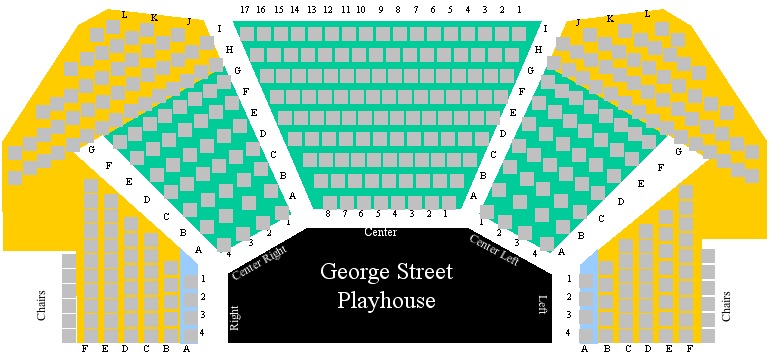 It is fairly easy in Theatre Manager to identify the accessible areas using colour, text, and/or an icon. We recommend changing the background area of the accessible seating to be blue (as per the image to the right) to clearly identify where they are in the venue.
It is fairly easy in Theatre Manager to identify the accessible areas using colour, text, and/or an icon. We recommend changing the background area of the accessible seating to be blue (as per the image to the right) to clearly identify where they are in the venue.
You may also want to put a legend on the map for 'Price A', 'Price B' and 'ADA seats' so that it is equality and abundantly clear where each area is.
Best Seating Setup
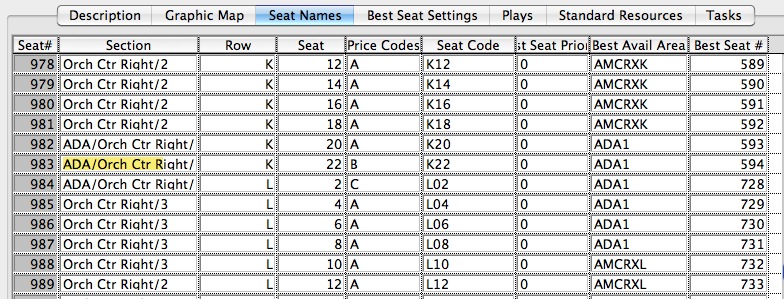 The setup for best seating has a some strategies for you to consider.
The setup for best seating has a some strategies for you to consider.
There are four columns that require special attention for ADA seating:
- Best Seat #: We recommend ADA seating be highest number in the Best Seat # column where possible. This means, the best seat algorithm will chose the ADA seats last - every time. It reduces the effect of them being selected by any patron unwittingly.
- Best Avail Area: Name the Best Avail Area column with a clearly identifying nomenclature such as ADA or WC. If you have multiple accessible areas, then name them ADA1, ADA2, ADA3. This way they are considered separate by Theatre Manager.
Notice in or example, there are only 3 ADA seats in this area (seats 982, 983, 984) but the ADA act requires that companion seats be available as well - up to 3 companion seats per ADA seat subject to availability. If you make them in the same row, add the caption ADA to the Best Avail Area for sufficient seats to meet your ADA requirements.
These seats should always have a higher Best Seat # than the actual ADA seats. This way, in cases of sellout, you can sell those seats to able-bodied person (they do not have to be saved for companion seats)

If you place a '#' at the end of a best available area, it has a special meaning. It causes MT to make two passes of the seats, offering a subset preferentially before offering the rest of the seats if nothing else is left.
- Seat Flag:: place a 1 in this column to indicate that there are notes associated with this seat (see next field - below)
- Seat Note:: Add a note to the seat clearly indicating that it is for ADA access. In the text, you may want to:
- label it as wheelchair, removable seat (call ahead), companion seat, bed capable, transfer only
- add other data that a lesser abled person may need in order to select the seat, such as accessible via ramp or elevator.
- Add a UTF8 wheelchair character to indicate accessibility. It will display online per the example below. The character was copied and pasted from this web site and displays in most browsers.
- some venues also include notes to indicate that fully capable patrons may be asked to move if they select this seat and other policies notes
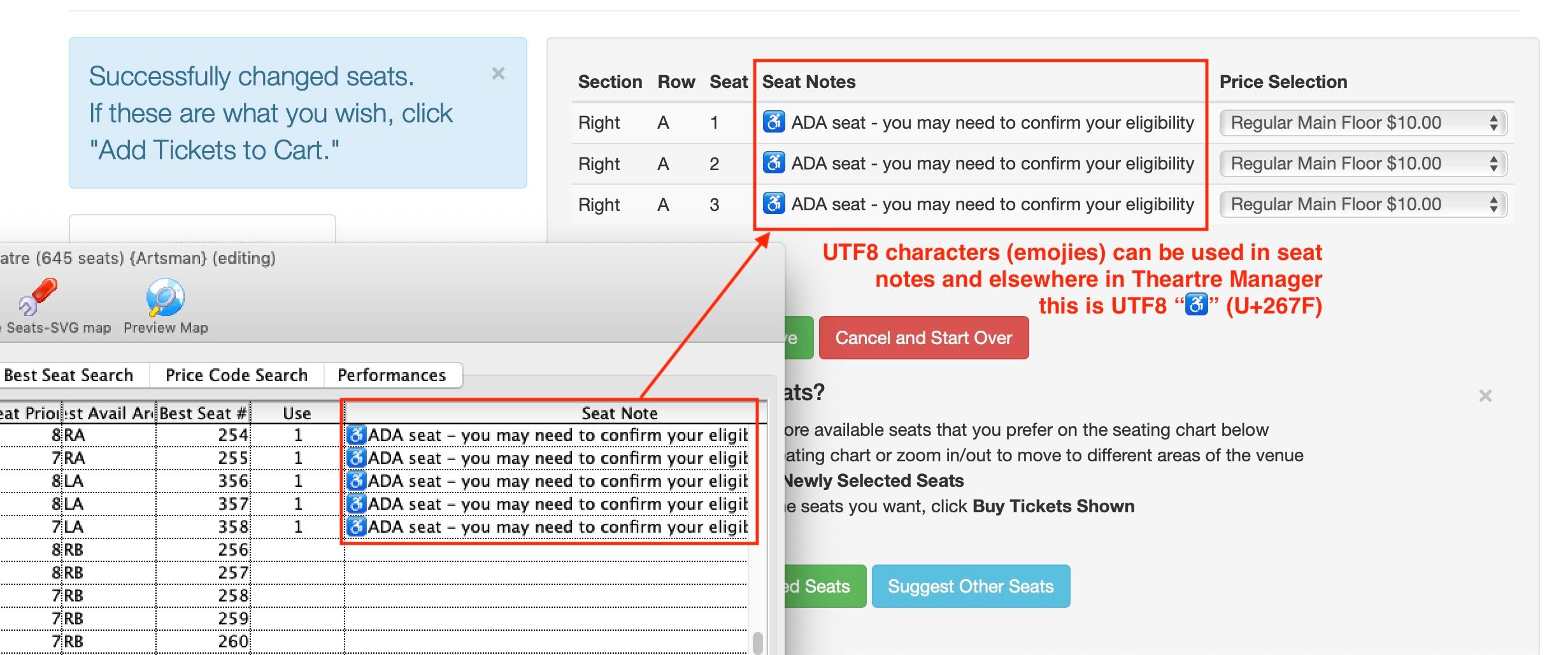
 |
Theatre manager has a feature called
Associated Seats that can be useful for ADA seating setup.
If you associate a group of ADA seats as the primary seat and companion seats, then booking one of them will automatically hold the others for the same patron until you manually release them. |
Identify ADA seats to Patron

An ADA requirement includes identification of the ADA seat and what it may mean to the patron (see sample to the right). For a patron requiring accessible seats, it should be clear what they selected. Conversely, you can also direct those who selected the seats in error to find some others.
You cannot prevent anyone buying ADA designated seats -- because the ADA act stipulates that anybody, ablebodied or not, can buy them on behalf of another. Fraud detection must be done after the fact (according to the act).
Adding Seat Notes
- Each and every seat in a reserved seating venue can have a 300 character Seat Note associated with it. It can be used to explain any ADA requirements or directions. This field can also be used to indicate an special seating notes like sightline restrictions if they are of benefit to your patrons, or a tag to show a picture that will display what the view is from the seat.
- There is a column called Use which is flag to indicate if the seat note is an internal note (0) or if it can be displayed on the web site to patrons (1). Normally ADA seating notes would have a 1 in this column. Notes appear on the tooltips for a seat at the box office and can be added to the online SVG graphic tooltip notes. You can also place comments and html tags within the seats notes if you wish.
- The standard web pages will display the tooltips if you provide them.
Searching for Tickets
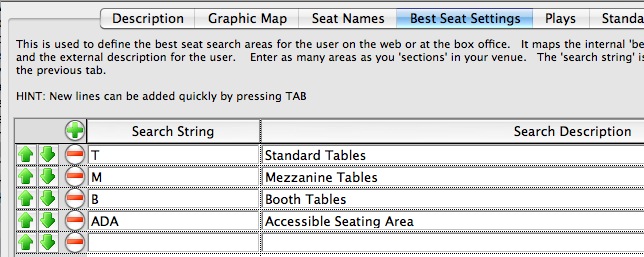 The 'Best Seat Settings' tab in the venue setup indicates how people can find tickets. If you name the seats in your accessible section 'ADA' or 'WC' or some equivalent terminology, then you can put in search areas into your web sales to help find those accessible seats.
The 'Best Seat Settings' tab in the venue setup indicates how people can find tickets. If you name the seats in your accessible section 'ADA' or 'WC' or some equivalent terminology, then you can put in search areas into your web sales to help find those accessible seats.
If you have multiple accessible sections, you could call them ADA1, ADA2, etc. and provide an individual search for each one.
Ticket Prices for ADA
However you may need to change your seat map so that the pricing of any seats in the ADA area match the proportion of seats in the entire house. For example, if your venue has:
- 100 seats at price 'A' (50% of the house - most expensive ticket)
- 60 seats at price 'B' (30% of the venue - mid range ticket)
- 40 seats at price 'C' (20% of the venue- least expensive ticket)
Note that our reading of the act does not state that all accessible tickets purchased by one person need be at the same price. That could mean that the accessible seats could be set up explicitly so that their prices match an exact proportion of the ticket prices in the rest of the venue.
There is also a fairness reading of how to set prices according to the act. If all your accessible seats are amongst your 'A' tickets, then you must follow the proportional pricing approach and make some price 'B' and 'C' seats available.
If all your accessible seating is amongst the 'C' area due to how the venue was constructed, then you will need to make the accessible seating at a 'C' price because you cannot arbitrarily charge more just to maintain proportionality. The principle cited in the act is that the price must be the same as if an able-bodied person was to purchase a ticket in that area.
Theatre Manager Implementation Approach
Once you have decided how many accessible tickets you want at each pricing area as appropriate for your venue, you enter that into the venue setup under the 'Seat Names' tab. Look for the column named 'Price Codes' and enter the Price codes against the ADA accessible seats - see the sample below.
Specifically, you will see in this venue that only 3 seats are marked ADA (982,983,984) and they have been given price codes A (seat 982), B (seat 983) and C (seat 984) as per proportionality and seating area for this venue.

Ticket Holds for ADA
- all non-accessible seats have been sold
- all non-accessible seats in a specific area have been sold, so accessible seats in that area may also be released
- all non-accessible seats in a designated price category have been sold, so remaining accessible seat can no be released to the public
If you do hold seats that are released periodically, you will also need to hold accessible seats in proportion to the public seats that are held back. (eg, if you hold 10% of a house for later, you need to hold 10% of the accessible seats). The interpretation of the act is very specific that the venue can exclude from the held count those seats count held for promoters, actors, and others held under contract.
Implementing in Theatre Manager
Implementing this in Theatre Manager is quite straightforward.
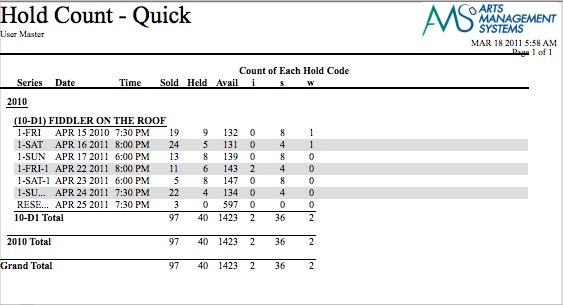 If you do hold seats for the public, then you must also hold the proportion of accessible seats. Run the ticket inventory report called Ticket Hold Counts-Quick to help determine total counts. This report may exported to excel or copy/pasted to excel and proportional calculations run.
If you do hold seats for the public, then you must also hold the proportion of accessible seats. Run the ticket inventory report called Ticket Hold Counts-Quick to help determine total counts. This report may exported to excel or copy/pasted to excel and proportional calculations run.- If you periodically release seats, check your house and release the ADA seats at the same time, in proportion.
- If you do not hold any seats (other than those promoter, actor, contracted seats, etc seats mentioned above), then you don't have to hold any accessible seating because (by definition) you will have designed the best seat algorithm to bias ADA seats as the last to be suggested and you will have guided able-bodied patrons not to pick those seats unless they need them.
- However, having no accessible seats does seem a bit harsh, so we'd recommend keeping at a small reserve of accessible seats on hold till you release all seats to the public before the performance - as we don't think that all people who use accessible seating will be as active on the internet at the proponents of the law might anticipate.
Policy Additions for ADA
Box Office Policies
- You cannot require people who buy accessible tickets online to visit the box office to pick up the tickets if you do not require abled people to do the same thing (same rules for all). However, you can monitor who uses your accessible seats by having ushers greet people in the accessible area. You are also allowed to reseat people in the accessible seats under some circumstances.
- You may have to adjust season subscription policies for renewing seats the following year if the subscription includes accessible seats. It appears that you can ask subscribers to attest in writing that they need accessible seating (but not for single tickets)
- If you allow an able person to buy a group of tickets on behalf of others, then you must also allow that same privilege to people who buy accessible seating. Such policies would mean you cannot require accessible seating to be returned to the box office for resale. It would also mean that a fully able person may end up in the accessible seating, if those tickets are bought by a disabled person and given away - and that means the abled person is fully entitled to sit in the accessible seating.
- Ticket holders of normal seating are allowed to change to accessible seating in a comparable location if seats are available when the individual presents the tickets.
Guarding against Fraudulent use of ADA seats
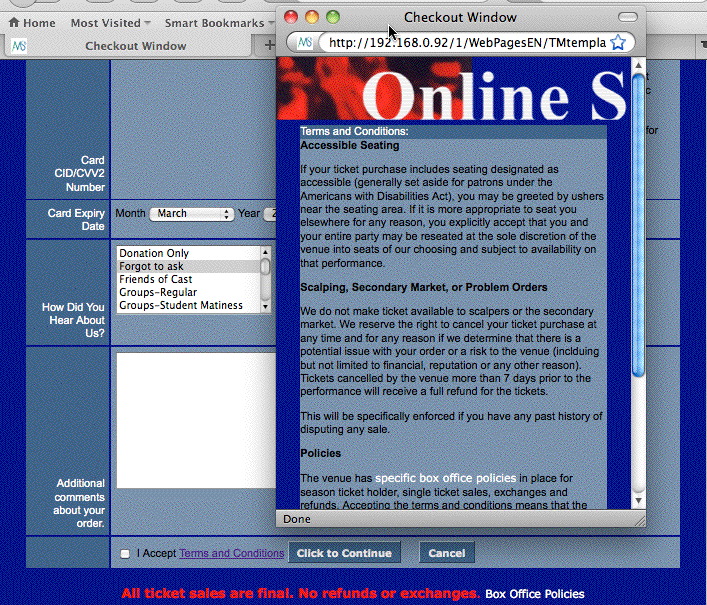 You can, however, use a feature in Theatre Manager web sales process to require people, at time of checkout, to read terms and conditions prior to accepting the credit card and completing the sale. Theatre Manager records that the person has validated reading the conditions.
You can, however, use a feature in Theatre Manager web sales process to require people, at time of checkout, to read terms and conditions prior to accepting the credit card and completing the sale. Theatre Manager records that the person has validated reading the conditions.
In those terms and conditions, you may put a policy wording that is supported by the act such as people 'attest' that they need the ADA seats if they purchased some and that they agree they may be moved under circumstances provided for in the act.
You may also want to put wording about scalpers, secondary sales, a link to your your box office policies, etc in the terms and conditions. Theatre Manager records that people clicked the checkbox on the web detail screen.
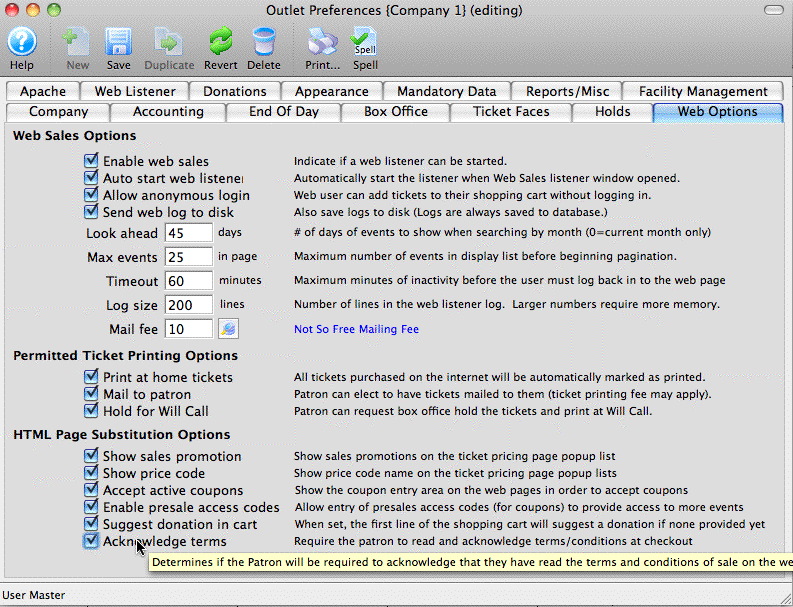 Requiring people to 'accept terms and conditions' of the sale is done by:
Requiring people to 'accept terms and conditions' of the sale is done by:
- ensuring that all standard web page changes have been made on the TM checkout page as per version 9.05 release notes
- That you are using version 9.05 or later of Theatre Manager
- That you have enabled the 'read terms and conditions' checkbox on the company preferences window as per the picture to the right.
Secondary Market
Appendix: Excerpt from the ADA Act
Section (f) is about ticketing, applies directly and is reproduced below.
- (1)
- (i) For the purposes of this section, 'accessible seating' is defined as wheelchair spaces and companion seats that comply with sections 221 and 802 of the 2010 Standards along with any other seats required to be offered for sale to the individual with a disability pursuant to paragraph (4) of this section.
- (ii) Ticket sales. A public accommodation that sells tickets for a single event or series of events shall modify its policies, practices, or procedures to ensure that individuals with disabilities have an equal opportunity to purchase tickets for accessible seating
- (A) During the same hours;
- (B) During the same stages of ticket sales, including, but not limited to, pre-sales, promotions, lotteries, wait-lists, and general sales;
- (C) Through the same methods of distribution;
- (D) In the same types and numbers of ticketing sales outlets, including telephone service, in-person ticket sales at the facility, or third-party ticketing services, as other patrons; and
- (E) Under the same terms and conditions as other tickets sold for the same event or series of events.
- (2) Identification of available accessible seating. A public accommodation that sells or distributes tickets for a single event or
series of events shall, upon inquiry
- (i) Inform individuals with disabilities, their companions, and third parties purchasing tickets for accessible seating on behalf of individuals with disabilities of the locations of all unsold or otherwise available accessible seating for any ticketed event or events at the facility;
- (ii) Identify and describe the features of available accessible seating in enough detail to reasonably permit an individual with a disability to assess independently whether a given accessible seating location meets his or her accessibility needs; and
- (iii) Provide materials, such as seating maps, plans, brochures, pricing charts, or other information, that identify accessible seating and information relevant thereto with the same text or visual representations as other seats, if such materials are provided to the general public.
- (3) Ticket prices.
- The price of tickets for accessible seating for a single event or series of events shall not be set higher than the price for other tickets in the same seating section for the same event or series of events. Tickets for accessible seating must be made available at all price levels for every event or series of events. If tickets for accessible seating at a particular price level cannot be provided because barrier removal in an existing facility is not readily achievable, then the percentage of tickets for accessible seating that should have been available at that price level but for the barriers (determined by the ratio of the total number of tickets at that price level to the total number of tickets in the assembly area) shall be offered for purchase, at that price level, in a nearby or similar accessible location.
- (4) Purchasing multiple tickets.
- (i) General. For each ticket for a wheelchair space purchased by an individual with a disability or a third-party purchasing such a ticket at his or her request, a public accommodation shall make available for purchase three additional tickets for seats in the same row that are contiguous with the wheelchair space, provided that at the time of purchase there are three such seats available. A public accommodation is not required to provide more than three contiguous seats for each wheelchair space. Such seats may include wheelchair spaces.
- (ii) Insufficient additional contiguous seats available. If patrons are allowed to purchase at least four tickets, and there are fewer than three such additional contiguous seat tickets available for purchase, a public accommodation shall offer the next highest number of such seat tickets available for purchase and shall make up the difference by offering tickets for sale for seats that are as close as possible to the accessible seats.
- (iii) Sales limited to fewer than four tickets. If a public accommodation limits sales of tickets to fewer than four seats per patron, then the public accommodation is only obligated to offer as many seats to patrons with disabilities, including the ticket for the wheelchair space, as it would offer to patrons without disabilities.
- (iv) Maximum number of tickets patrons may purchase exceeds four. If patrons are allowed to purchase more than four tickets, a public accommodation shall allow patrons with disabilities to purchase up to the same number of tickets, including the ticket for the wheelchair space.
- (v) Group sales. If a group includes one or more individuals who need to use accessible seating because of a mobility disability or because their disability requires the use of the accessible features that are provided in accessible seating, the group shall be placed in a seating area with accessible seating so that, if possible, the group can sit together. If it is necessary to divide the group, it should be divided so that the individuals in the group who use wheelchairs are not isolated from their group.
- (5) Hold and release of tickets for accessible seating.
- (i) Tickets for accessible seating may be released for sale in certain limited circumstances. A public accommodation may release unsold tickets for accessible seating for sale to individuals without disabilities for their own use for a single event or series of events only under the following circumstances
- (A) When all non-accessible tickets (excluding luxury boxes, club boxes, or suites) have been sold;
- (B) When all non-accessible tickets in a designated seating area have been sold and the tickets for accessible seating are being released in the same designated area; or
- (C) When all non-accessible tickets in a designated price category have been sold and the tickets for accessible seating are being released within the same designated price category.
- (ii) No requirement to release accessible tickets. Nothing in this paragraph requires a facility to release tickets for accessible seating to individuals without disabilities for their own use.
- (iii) Release of series-of-events tickets on a series-of-events basis.
- (A) Series-of-events tickets sell-out when no ownership rights are attached. When series-of-events tickets are sold out and a public accommodation releases and sells accessible seating to individuals without disabilities for a series of events, the public accommodation shall establish a process that prevents the automatic reassignment of the accessible seating to such ticket holders for future seasons, future years, or future series, so that individuals with disabilities who require the features of accessible seating and who become newly eligible to purchase tickets when these series-of-events tickets are available for purchase have an opportunity to do so.
- (B) Series-of-events tickets when ownership rights are attached. When series-of-events tickets with an ownership right in accessible seating areas are forfeited or otherwise returned to a public accommodation, the public accommodation shall make reasonable modifications in its policies, practices, or procedures to afford individuals with mobility disabilities or individuals with disabilities that require the features of accessible seating an opportunity to purchase such tickets in accessible seating areas.
- (i) Tickets for accessible seating may be released for sale in certain limited circumstances. A public accommodation may release unsold tickets for accessible seating for sale to individuals without disabilities for their own use for a single event or series of events only under the following circumstances
- (6) Ticket transfer.
- Individuals with disabilities who hold tickets for accessible seating shall be permitted to transfer tickets to third parties under the same terms and conditions and to the same extent as other spectators holding the same type of tickets, whether they are for a single event or series of events.
- (7) Secondary ticket market.
- (i) A public accommodation shall modify its policies, practices, or procedures to ensure that an individual with a disability may use a ticket acquired in the secondary ticket market under the same terms and conditions as other individuals who hold a ticket acquired in the secondary ticket market for the same event or series of events.
- (ii) If an individual with a disability acquires a ticket or series of tickets to an inaccessible seat through the secondary market, a public accommodation shall make reasonable modifications to its policies, practices, or procedures to allow the individual to exchange his ticket for one to an accessible seat in a comparable location if accessible seating is vacant at the time the individual presents the ticket to the public accommodation.
- (8) Prevention of fraud in purchase of tickets for accessible seating. A public accommodation may not require proof of disability, including, for example, a doctor's note, before selling tickets for accessible seating.
- (i) Single-event tickets. For the sale of single-event tickets, it is permissible to inquire whether the individual purchasing the tickets for accessible seating has a mobility disability or a disability that requires the use of the accessible features that are provided in accessible seating, or is purchasing the tickets for an individual who has a mobility disability or a disability that requires the use of the accessible features that are provided in the accessible seating.
- (ii) Series-of-events tickets. For series-of-events tickets, it is permissible to ask the individual purchasing the tickets for accessible seating to attest in writing that the accessible seating is for a person who has a mobility disability or a disability that requires the use of the accessible features that are provided in the accessible seating.
- (iii) Investigation of fraud. A public accommodation may investigate the potential misuse of accessible seating where there is good cause to believe that such seating has been purchased fraudulently.